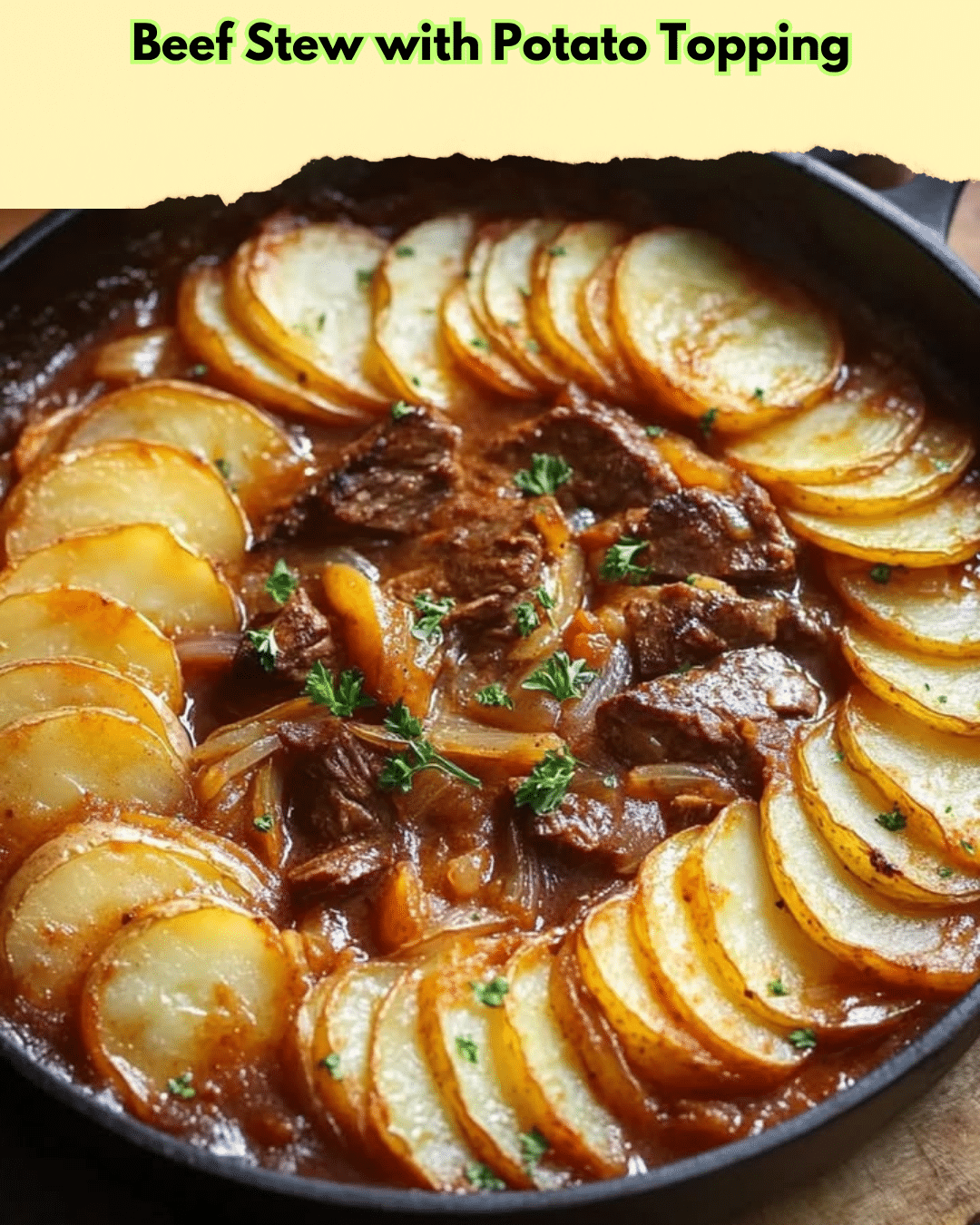Beef Stew with Potato Topping: A Heartwarming Culinary Delight
Discover the comfort and warmth of a traditional beef stew topped with a delightful potato crust. This Beef Stew with Potato Topping brings together tender beef chunks and hearty vegetables simmered in rich and savory gravy. Perfect for cold winter nights, this dish offers a satisfying meal that’s guaranteed to please the entire family. With its simple preparation and exquisite flavors, this recipe will make you feel like a seasoned chef in your own kitchen.
Quick Recipe Highlights
- Flavor Profile: This beef stew blends savory meat flavors with aromatic herbs, providing a satisfying and rich taste adventure.
- Texture: The combination of tender beef, soft vegetables, and the crispy potato topping offers a delightful textural variety with every bite.
- Aroma: Experience the mouth-watering scent of rosemary and garlic blending with the deep aroma of slow-cooked beef.
- Visual Appeal: The golden potato topping layered over the stew creates an eye-catching centerpiece dish.
- Skill Level Needed: While some cooking experience helps, this recipe is manageable with detailed guidance and techniques.
- Special Equipment: You may need a Dutch oven or a heavy-bottomed pot and an oven-safe baking dish for the potato topping.
Recipe Overview
- Difficulty Level: Medium, due to the stew’s multi-step process involving browning, simmering, and baking.
- Category: Main Course, perfect for dinner gatherings or family meals.
- Cuisine: Rooted in classic European traditions, this dish showcases timeless culinary techniques.
- Cost: Moderately priced, mainly due to the beef cuts; however, it’s economical considering the serving size.
- Season: Ideal for winter when you crave hearty, warming meals.
- Occasion: Suitable for family dinners, holiday meals, or any comforting evening at home.
Why You’ll Love This Recipe
The taste and texture appeal of this beef stew will captivate you with every spoonful. The tender beef falling apart in your mouth, combined with the creamy potato topping, creates a harmony of flavors that caters to both the palette and nostalgia. Convenience is another factor; while it takes a bit of time to cook, the recipe doesn’t demand constant supervision, allowing you to prepare other things or simply relax. Nutritionally, this stew offers a balance of protein and fiber-filled vegetables, making it both satisfying and wholesome. It’s a dish that brings people together, whether you’re serving it at a family dinner or impressing guests. Additionally, using everyday ingredients makes it accessible, cost-effective, and an easy addition to your meal rotation without stretching the budget.
Historical Background and Cultural Significance
Beef stew’s origin can be traced back to medieval Europe, where similar dishes were created by slow cooking tougher meat cuts to tenderize them. This rich stew has cultural importance in many countries where local variations have flourished, incorporating native ingredients and cultural tastes. Over time, the recipe has evolved, adopting influences from regional flavors and cooking methods, leading to the diverse versions enjoyed today, such as Ireland’s beloved Irish stew. Regional variations reflect the local produce and culinary traditions, each adding a unique touch to the traditional beef stew.
Ingredient Deep Dive
Beef serves as the star ingredient, providing the dish’s signature richness. Its history as a culinary staple dates back centuries, with cultures worldwide valuing it for its flavor and versatility. Nutritionally, beef is an excellent source of protein, iron, and B vitamins, essential for muscle building and maintaining good health. When selecting beef, choose cuts labeled as chuck or stewing beef for optimal tenderness after slow cooking. Store fresh beef in the coldest part of your refrigerator, and consume it by the use-by date for best quality. For substitutions, lamb or pork can be used for different flavor profiles.
Potatoes, a humble yet essential component, offer both structural and flavor elements to the stew. Known for their origins in South America, potatoes became a dietary staple across Europe and beyond, contributing to global menus. Rich in carbohydrates, potassium, and vitamin C, they offer excellent energy and nutrition. Opt for waxy potatoes to ensure they hold their shape during cooking. Store them in a cool, dark place to extend their shelf life. If potatoes are unavailable, ingredients like sweet potatoes, parsnips, or turnips can provide interesting variations.
Common Mistakes to Avoid
- Overcrowding the pan when browning beef, which can result in steaming instead of searing.
- Skipping the flouring step for the beef, which helps thicken the stew.
- Using insufficient liquid, leading to drying out before the meat becomes tender.
- Cooking with high heat, which can make the beef tough.
- Adding potatoes too early can lead to them disintegrating into the stew liquid.
- Not seasoning adequately throughout the cooking process, resulting in uneven flavor.
- Neglecting to skim the fat which can lead to a greasy texture.
- Cooking exclusively on the stovetop, missing the additional flavor from baking the topping.
- Using overly lean beef cuts can result in dry and tough texture.
- Opening the oven door too often when baking the potato topping, affecting consistency.
Essential Techniques
Browning beef correctly is crucial to achieving depth in flavor. It’s important because the Maillard reaction that occurs adds complexity and deepens the stew’s overall taste. Master this step by ensuring the beef is patted dry before cooking and the pan is adequately hot to avoid steaming. Common pitfalls include overcrowding the pan, which hampers browning; instead, work in batches if needed. Visual cues for success include a rich, caramelized crust on the beef pieces.
Slow cooking is another key technique, allowing flavors to meld and meat to become tender. Maintain a gentle simmer, ensuring the stew doesn’t boil, which helps prevent toughening the meat. To check doneness, the beef pieces should fall apart easily when prodded with a fork, and the gravy should have reduced to a thick, velvety consistency.
Pro Tips for Perfect Beef Stew with Potato Topping
For enhanced flavor, marinate the beef overnight with herbs and a splash of wine. This step infuses the meat with aromatic notes, contributing depth to the finished dish. In cases where time allows, consider making the stew a day ahead; flavors develop wonderfully, and any excess fat can be easily removed when chilled. Ensure potatoes are uniformly sliced to guarantee even cooking during the baking step. To achieve a crisp potato topping, finish the stew under a broiler. Incorporate a teaspoon of vinegar or a squeeze of lemon juice at the end to brighten the dish’s flavors. For a thicker stew, remove some liquid, blend, and stir back into the pot. To save prep time, consider using pre-cut stew vegetables from your grocer.
Variations and Adaptations
Regional variations abound with this dish. In France, incorporate red wine and hearty Provencal herbs to create a beef bourguignon-style stew. Season for winter by adding roasted root vegetables like turnips and parsnips for added depth. Modify for dietary preferences by using cauliflower for the topping instead of potatoes for a low-carb alternative. For a flavor twist, add spicy elements like jalapeños and cumin for a Tex-Mex adaptation. Those preferring extra texture can stir in cooked grains, such as barley, for a chewy contrast. Presentation-wise, replace the potato layer with a puff pastry crust for an elevated aesthetic.
Serving and Presentation Guide
Plating techniques can elevate the visual appeal, such as using a shallow bowl so the potato topping sits visibly. Consider creative garnishing, like finely chopped parsley or thyme sprigs, to add color contrast. Accompany this dish with fresh, crusty bread or a simple salad for balance. On a more luxurious note, pair with rich side dishes like buttered green beans or glazed baby carrots. Temperature matters; serve the stew hot for best flavor and texture enjoyment. For controlled portions, scoop individually onto plates before family-style serving, helping avoid overindulgence.
Wine and Beverage Pairing
Pair the beef stew with a robust red wine like a Cabernet Sauvignon or a Merlot for a classic complement. The wine’s tannins harmonize with the rich beef flavor and cut through the starchiness of the potatoes. Non-alcoholic alternatives include a hearty grape juice blend or an herbal iced tea that refreshes the palate. In colder months, consider pairing with a spiced cider for an inviting option. Temperature considerations suggest serving red wines slightly below room temperature or the chosen beverage chilled for contrast. Complete the experience with a post-meal espresso or rich black tea serving for refreshment.
Storage and Shelf Life
For leftovers, proper storage involves sealing the beef stew in airtight containers, ensuring longevity of flavor and preventing contamination. Ideally kept in the refrigerator, it remains best consumed within three to four days. Use shallow containers for more even cooling and reheating temperatures. Look for signs of spoilage such as an off smell or mold growth, which indicate it’s time to discard. When reheating, bring to a rolling boil to kill any bacteria that may have developed. To freeze, transfer to freezer-safe containers, keeping for up to three months, and thaw in the refrigerator before reheating.
Make Ahead Strategies
The beef stew can be easily prepped in stages. Begin by cooking the beef stew a day before serving, refrigerating to allow flavors to deepen overnight. If needing to store between steps, ensure the stew cools completely before refrigeration to maintain quality. Assess the impact on flavor and texture after storing, which often improves with brief chilling. For assembly tips, keep components separate until the final bake to maintain texture contrast. Reheat the stew gently to avoid compromising the beef’s tenderness, adding a splash of broth if needed to loosen the texture. Fresh herbs can be added just before serving to enliven the dish.
Scaling Instructions
When halving the recipe, adjust ingredient portions accordingly while retaining essential cooking times for the stew’s foundational methods. Consider using smaller equipment, such as a compact Dutch oven, to accommodate reduced quantities. Doubling or tripling requires careful consideration of pot size to avoid overcrowding, which can inhibit even cooking. Extending cooking times may be necessary to ensure flavors fully develop when increasing portions significantly. Account for additional storage requirements, ensuring upright containers to properly secure liquid components. When adjusting scale, taste for seasoning at each expansion phase to maintain balance.
Nutritional Deep Dive
This beef stew’s macro breakdown offers a gratifying balance of proteins, carbohydrates, and fats, making it suitable for balanced diets. The inclusion of vegetables enriches the micronutrient profile, with vitamin A and C contributing to a robust immune system. Overall, the dish provides health benefits through its high protein and fiber content, fostering muscle maintenance and digestive health. Keep dietary considerations in mind, such as sodium levels, which can be adjusted by using reduced-sodium broth. Analyze portions to ensure calorie intake aligns with dietary goals, supporting sustainable weight management practices.
Dietary Adaptations
For gluten-free needs, substitute all-purpose flour with a gluten-free blend or cornstarch to thicken the stew. Create a dairy-free version by opting for olive oil instead of butter when preparing the potato topping, while the stew itself remains dairy-free. A vegan adaptation can utilize chickpeas or mushrooms in place of beef while maintaining similar textures and taste. For low-carb, reduce potatoes and add cauliflower instead, keeping carbohydrate intake nominal. The keto approach adheres well, emphasizing high protein and fats from choice-cut beef. Paleo enthusiasts will find the unprocessed, natural ingredients’ benefits align perfectly with their diet’s principles.
Troubleshooting Guide
If experiencing texture issues like dry meat, it’s often due to overcooking; ensure enough moisture throughout cooking for optimal tenderness. Correct flavor imbalances by adjusting salt, acid (vinegar or lemon), or sweet elements for equilibrium. Temperature issues, such as undercooked potatoes, necessitate additional cooking at regulated heat levels. Handle equipment challenges by verifying compatibility with oven-safe features, particularly if browning and baking in one pot. Substitute ingredients wisely by using known equivalents, like yams for sweet notes when potatoes are unavailable. Timing concerns require adjusting heat and liquid to compensate for variations in cooking speeds and thickness.
Recipe Success Stories
Our community has shown remarkable enthusiasm, with feedback praising the balanced flavor and heartwarming essence of this beef stew. Successes often feature seasonal veggie additions, like sweet potatoes, which impart additional layers of flavor. Adaptation zones see readers making health-conscious adjustments without losing the dish’s comforting charm. Enthusiasts have shared inventive presentation methods, such as serving in individual ramekins for elegance. Reader suggestions often involve convenient tips like pre-chopping veggies to streamline prep. Photography tips abound, focusing on cross-sectional shots to showcase the stew’s vibrant colors juxtaposed against the golden potato topping.
Frequently Asked Questions
What cut of beef is best for stew? Use tougher cuts like chuck roast, which become tender when slow-cooked. These cuts also add richer flavor due to the marbling of fat.
How can I fix an overly salty stew? Add a raw potato to absorb excess salt, or balance with sweetness, like honey or sugar, in small increments to counterbalance.
Is it necessary to brown the beef? Yes, browning adds depth and complexity to the stew through the Maillard reaction, enhancing both flavor and color.
Can I make this recipe in an Instant Pot? Yes, use the sauté function for browning, then pressure cook for about 35 minutes on high, ensuring a quick release of pressure for best results.
What wine pairs best with beef stew? Full-bodied red wines like Cabernet Sauvignon complement the rich flavors, while a Shiraz also adds harmonious notes.
How do I thicken a watery stew? Add a slurry made of flour or cornstarch and water, reducing while stirring until the desired thickness is achieved.
What can I use instead of potatoes for topping? Consider using sweet potatoes or a combination of cauliflower and cheese for a low-carb alternative.
How can I make my stew more flavorful? Ensure proper seasoning throughout cooking, and consider adding herbs like thyme and bay leaf early in the process for infusion.
Can leftovers be frozen? Yes, they store well in airtight containers when frozen promptly, perfect for reheating later as a quick meal option.
How should I reheat beef stew with potato topping? Reheat gently on the stovetop or in the oven to maintain texture without drying out, adding broth if needed.
Why does my stew taste flat? Enhance the dish with an acidity component like vinegar or a squeeze of lemon to elevate and balance flavors.
Is a vegetarian alternative available? Yes, replace beef with mixed mushrooms or legumes like lentils for a hearty, vegetarian meal.
Additional Resources
Explore related recipes such as a classic Irish stew or try your hand at a sophisticated beef bourguignon following our detailed guides. Our technique guides offer insights into perfect browning and mastering slow cooking for succulent results. For ingredient information, delve into our detailed articles on selecting the best beef cuts and complementary herbs and spices. Recommendations for essential equipment highlight dutch ovens and quality knives for efficient preparation. Seasonal variations inspire creativity, with tips for incorporating produce that aligns with the time of year, making the beef stew with potato topping adaptable year-round.
Print
Beef Stew with Potato Topping
Description
A hearty beef stew topped with creamy mashed potatoes, perfect for a comforting dinner.
Ingredients
For the Crust:
- 1 lb beef chuck, cut into cubes
- 2 cups beef broth
- 1 onion, chopped
- 3 carrots, sliced
- 2 tbsp tomato paste
- 1 tsp dried thyme
- Salt and pepper to taste
- 4 cups mashed potatoes (prepared)
Instructions
1. Prepare the Crust:
- Season beef cubes with salt and pepper.
- In a large pot, brown the beef cubes over medium heat. Remove and set aside.
- In the same pot, sauté onions and carrots until softened. Stir in tomato paste and thyme.
- Return beef to the pot, add beef broth, and bring to a simmer. Cover and cook until beef is tender.
- Preheat oven to 375°F.
- Transfer stew to a baking dish, spread mashed potatoes over the top, and bake until potatoes are golden brown.
Notes
You can customize the seasonings to taste.




